This post may contain affiliate links. Please read our disclosure policy.
Ashta, Lebanese milk pudding, is so versatile it can be used as a topping for fresh fruit, pancakes, or as a filling. The creamy texture and fragrant floral waters will have you hooked!
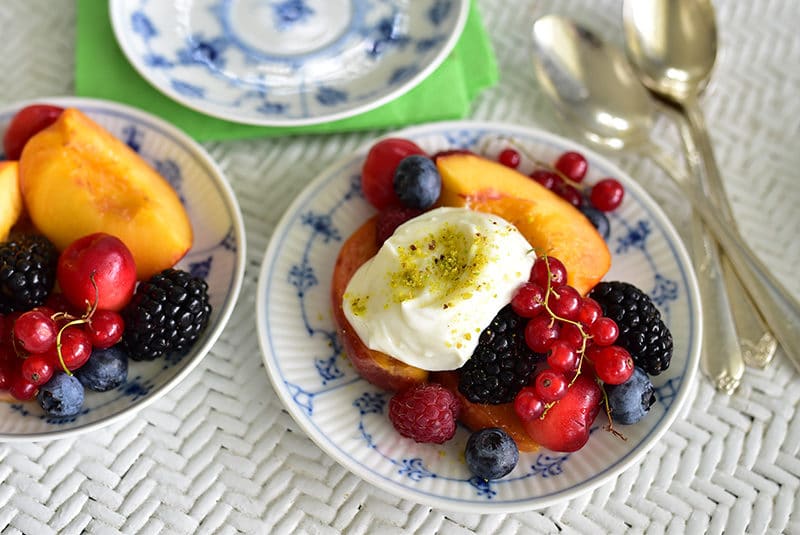
What is Ashta?
Lebanese ashta cream is a ubiquitous Lebanese milk pudding, fragrant with orange blossom and rose water. This ashta recipe uses whole milk and cornstarch, but recipes abound and are quite varied, some using white bread as the thickener—and none using eggs, as in traditional French pastry filling. It’s creamy, and without any eggs, the milky pudding allows the flavor of the flower waters to shine.
Ashta is traditionally served in a little pancake for dessert, as a topping for fresh fruit, or as a filling for knafeh and phyllo pastries.
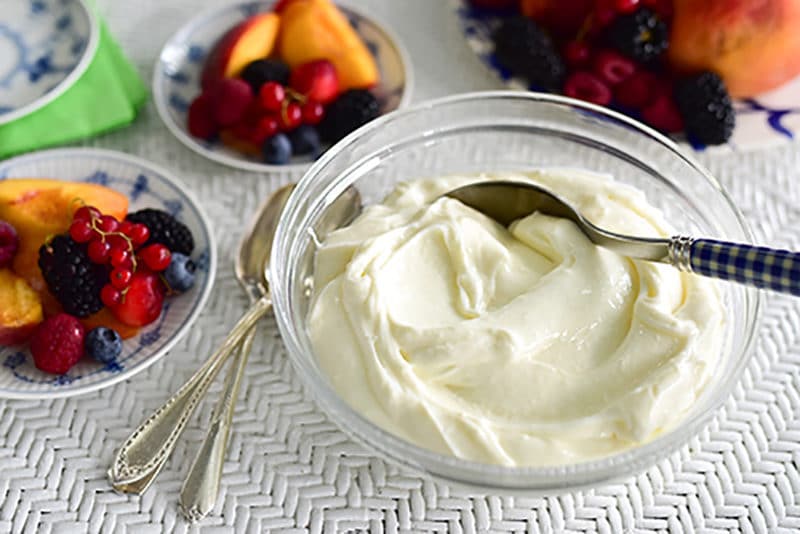
Ashta Ingredients
- Whole milk. Use whole milk for the best flavor, and make sure your milk is chilled.
- White vinegar. To curdle the milk and separate the cream from the whey.
- Cornstarch. To make a pudding with some of the milk. Although there are many ways to make homemade ashta cream, this pudding method makes the smoothest and creamiest ashta!
- Granulated sugar. Many ashta recipes leave out the sugar because it’s often topped with simple syrup, but I think at least a little sugar is key in the flavor.
- Orange blossom water and rose water. Use the best quality flower waters you can find. My recommendations are the orange blossom water and rose water from Mymoune.
- Fresh fruit. Use any fresh fruit you like. Peaches, nectarines, cherries, blueberries, currants, and raspberries pair beautifully with ashta!
- Ground pistachios. To sprinkle on top as a garnish.
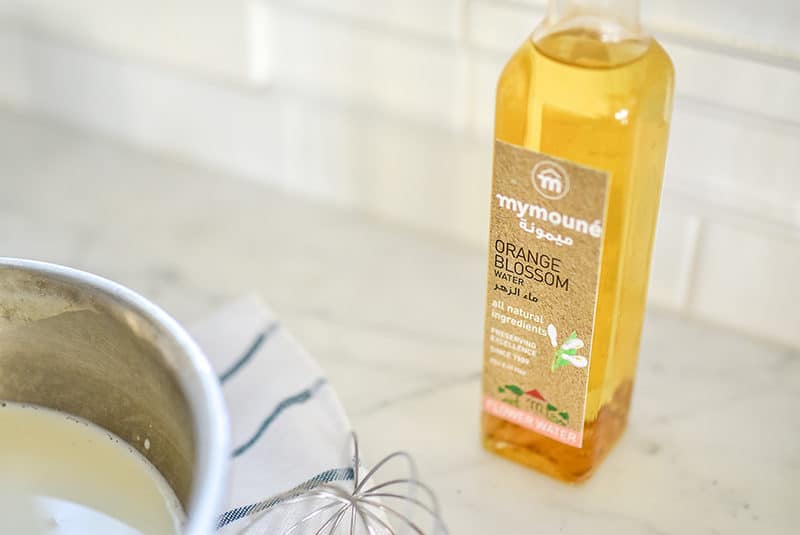
How to Make Ashta Cream
Step 1: Curdle the milk. In a medium saucepan, combine 6 cups of the milk with the vinegar and heat over medium-high heat. Stir the milk until it is steaming and the whey and cream separate. Place a strainer over a bowl. Turn off the heat and use a slotted spoon to put the clotted cream in the strainer. Discard the whey left in the saucepan.
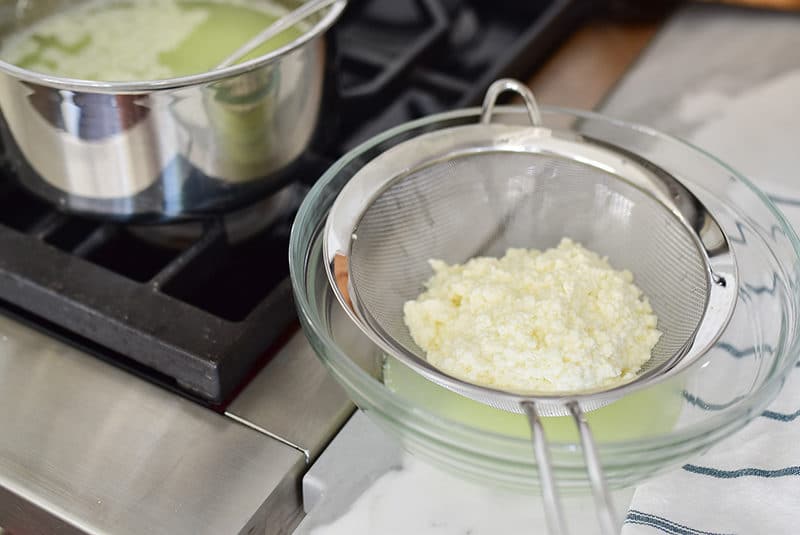
Step 2: Make the pudding. In another medium saucepan (or rinse the last one out), whisk the remaining 2 cups of milk with the cornstarch and sugar. Cook the pudding over medium heat, whisking constantly until it thickens, about 5 minutes, and remove the cream from the heat.
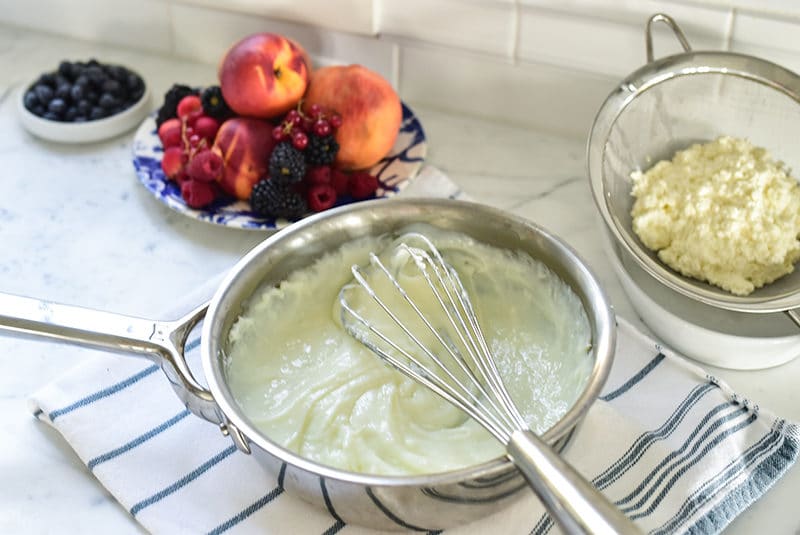
Step 3: Smooth out the ashta. To the pudding, add the strained clotted cream, orange blossom and rose water, whisking until fairly smooth. Use an immersion blender or other blender to smooth the cream. Put it in a bowl, and place plastic wrap directly onto the surface of the cream to prevent a skin from forming. Chill for at least one hour and up to one week before serving.
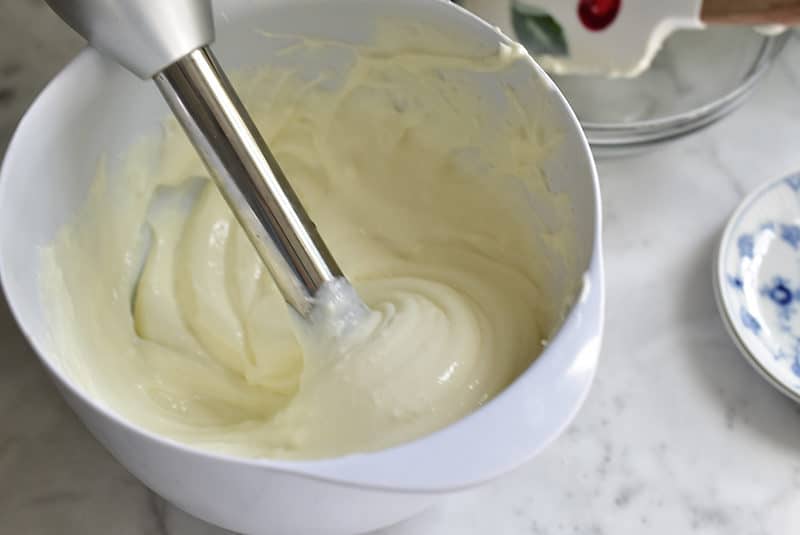
Step 4: Serve. Before serving, blend the cream again. Arrange the fruit in small bowls and top with a dollop of the ashta. Sprinkle with ground pistachios and serve immediately.
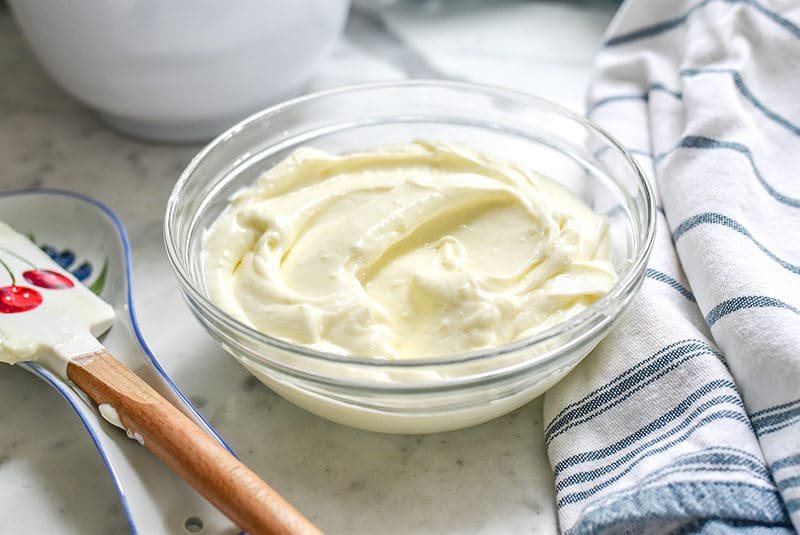
Helpful Tips
- Use whole milk. The milk needs to have enough fat content for it to curdle nicely and leave you with a rich and creamy ashta cream. So say no to 2% and skim milk, and go for the good ‘ole whole milk. It is also fine to substitute up to half of the whole milk with heavy cream and then to top the fruit and ashta with whipped cream too!
- Whisk the pudding constantly. This is no time to be chatting on the phone with your cousin! Make sure you’re whisking the pudding as it cooks to ensure it cooks evenly and you don’t have any hardened bits at the bottom of the pan.
- Let the plastic wrap touch the ashta. It’s important to place the plastic against the entire surface of the ashta cream when chilling it in the fridge, to avoid a skin forming. We want creamy and smooth ashta, so if you end up with a little skin, scrape it off before you re-blend it and serve.
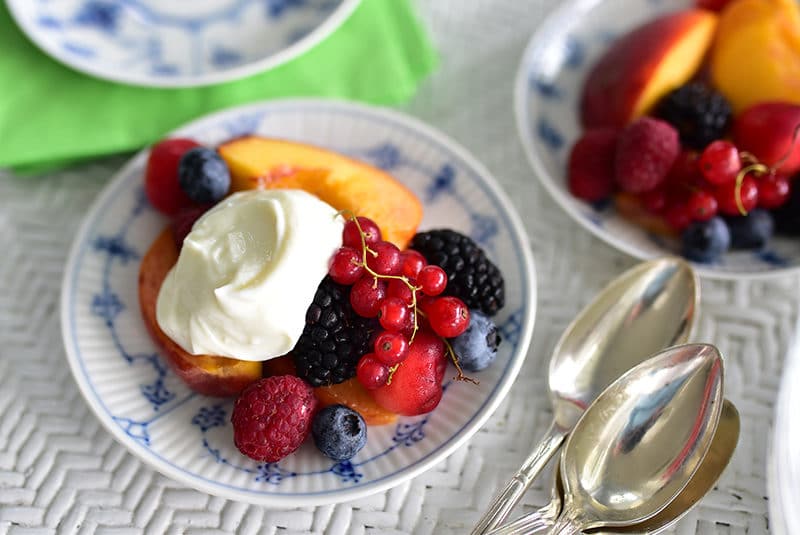
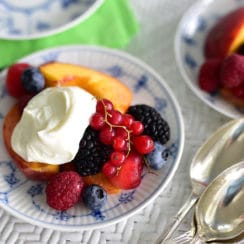
Ashta Cream
Ingredients
- 8 cups whole milk, cold
- 2 tablespoons white vinegar
- ¼ cup cornstarch
- 3 tablespoons granulated sugar
- 2 teaspoons orange blossom water
- 1 teaspoon rose water
- 4 cups Fresh fruit, such as peaches, nectarines, cherries, blueberries, currants, raspberries
- Ground pistachios, for serving
Instructions
- In a medium saucepan, combine 6 cups of the milk with the vinegar and heat over medium high heat.
- Stir the milk until it is steaming and the whey and cream separate. This will happen swiftly.
- Place a strainer over a bowl. Turn off the heat and use a slotted spoon to remove the clotted cream to the strainer. Discard the whey left in the saucepan.
- In another medium saucepan (or rinse the last one out), whisk the remaining 2 cups of milk with the cornstarch and sugar.
- Cook the pudding over medium heat, whisking constantly until it thickens, about 5 minutes.
- Remove the cream from the heat. Add the strained clotted cream and flower waters, whisking until fairly smooth. Use an immersion blender or other blender to smooth the cream.
- In a bowl, place plastic wrap directly onto the surface of the cream to prevent a skin from forming. Chill for at least one hour and up to one week before serving.
- Before serving, blend the cream again. Arrange the fruit in small bowls and top with a dollop of the ashta. Sprinkle with ground pistachios and serve immediately.
Nutrition
Nutrition information is automatically calculated, so should only be used as an approximation.


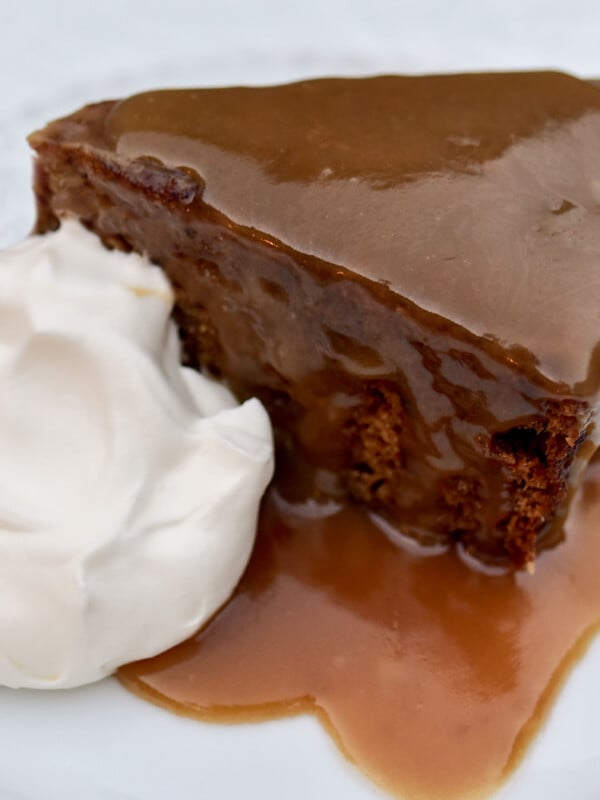
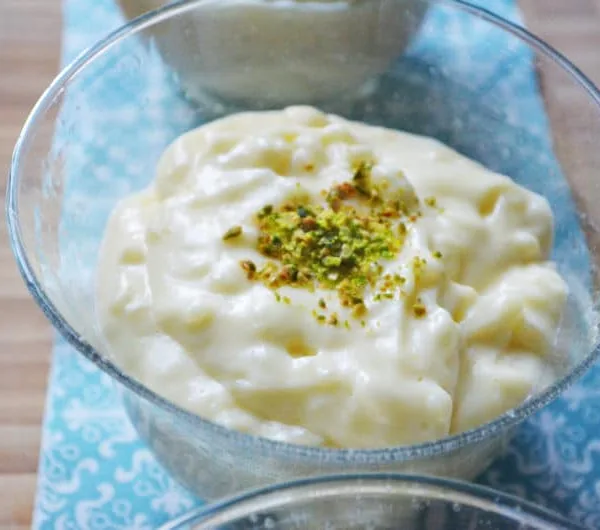







Love reading your emails .. and very happy to see more of “you” back in the ‘conversations’ .. which I hope means some of the health, business , & other concerns in your life have smoothed out .. lessening chaos & allowing a return to doing what you love!! God Bless!!
About Ashta .. I have been using unsweetened greek yogurt as a ‘base’ instead of making the milk pudding .. have had good response with less effort.
Thanks so much Alexandra for your beautiful words and blessings. How sweet and kind. Your ashta sounds really good and interesting–do you flavor the yogurt, and do anything else with it?
Almost every recipe for this says “sometimes thickened with bread”, but no recipe giving the amount used to substitute from cornstarch.
A friend had a version of this in Ann Arbor MI about 30 years ago, that was supposedly mostly made with cream and pita, probably an Egyptian version.
Can you suggest anything? If I were thickening some with pita, it would use pita crumbs.
Marina, when I developed this recipe I saw the bread thickener in my research. I didn’t find that it thickened so well so I opted for cornstarch. Must be that you will soften the bread in the milk so it dissolves so to speak, and then cook together with the cream. I think you will need lots of the bread-milk mixture to create a thick base.
HI! Would there be any benefit to making this with milk and half and half?
when i make ricotta i do that but was wondering if the texture would be off the ashta.
Thank you
Oh delicious, I think that would work well and enrich the ashta!
Hello there,
I do understand the need to privately mull, to listen quietly without the loud sounds of others’ wishes drowning out the whispers of creativity.
I am thrilled you hear the call to create a book on Lebanese pastry! If I could pre-order today I would.
If you ever need a recipe tester, just say the word. Have done so for Cook’s Illustrated, and a couple well known bakers. Of course, besides trying to be helpful, I am guilty of selfishly wanting to have access to recipes sooner, lol.
Thanks for sharing your heart’s desire with us. I know the book will enchant the world.
Cheers,
Anne
Anne, wonderful! Thank you!
Hello,
Last night we enjoyed a delicious dinner at Phoenician Taverna restaurant in Cincinnati, OH. We loved the Ashta with orange flower syrup and pistachios. I found your recipe while search for one I could make at home, so you know I ended up in the right place! Thank you so much for this post and I’ll let you know how this turns out for me.
Karen, I am so happy to hear that you landed here in your search for ashta! Love to hear how you like it. Your meal at Phoenician Taverna sounds so fun and delicious!
Wow .. this looks like it’s the one definitive recipe for homemade Ashta ! A pastry and savory bread and pie book ( Fatayer . Manoushe . Sfiha etc)is much needed with accurate tested recipes …
Can’t wait to try this — it sounds like the perfect child of white cheese and corn starch pudding! A thought: instead of discarding the whey, you can use it to make Jennifer Reese’s “everyday bread” (recipe available in the “look inside” here: https://www.amazon.com/Make-Bread-Buy-Butter-Shouldnt-ebook/dp/B004T4KXMS). The only problem with doing this is that once you do it once, you’ll be compelled to do it every time you make ashta or white cheese!
Great idea, thank you!
I remember my Mom making this ONCE and only once. She used an aluminum pan which leached and turned the Ashta a blue color. She got so frustrated she threw it all away. But I got to taste it before she dumped it out, I didn’t mind the blue tint and it tasted wonderful. However the perfectionist in her did not tolerate any thing that did not meet her tough criteria and blue Ashta was not up to her standards
That is so funny!!!!! Thanks Mary for sharing!
I just came across your site and find it so pleasing to read your little stories that I can relate to, along with your wonderful recipes. Your hummus is absolutely delish and I’ve made it each time it runs out. Your recipes are divine and I’ve so missed making my family’s Lebanese food. You got me hooked! Thanks for your great recipes.
How sweet Roseanne–that means a lot. Thank you!
A Lebanese pastry cookbook written by you?? Ummm, can I pre-order it NOW??? :-)) I’d be all over that one in a heart beat! I’ve been cooking my way through your current cookbook and having the time of my life! My husband is Lebanese and we married three years ago. My sister-in-law said your recipes are the closest to their old family recipes. My introduction to Lebanese pastries (and Lebanese cooking in general) was a maamoul mold in his kitchen and I had no idea what it was for. He told me it was his mothers and they were usually done at Easter. I started looking up recipes and videos and made a batch for Easter that year – having never tasted them or even seen them in person. At the time I did not know that no one in his family had made them since his mother and she passed away many years ago. I’ve improved my recipes since then and I’ve been hooked ever since on learning Lebanese cooking – especially the pastries!! I found this ashta cream recipe a year or so ago and it was absolutely incredible. This one used white bread and was very, very smooth. Here is the link to the video. https://www.youtube.com/watch?v=C41Zga9G_Rg Looking forward to your next recipe!! Lynette
Thank you so so much Lynette for all of your kind encouragement and family stories! AND for the ashta recipe you like–will have to try it!